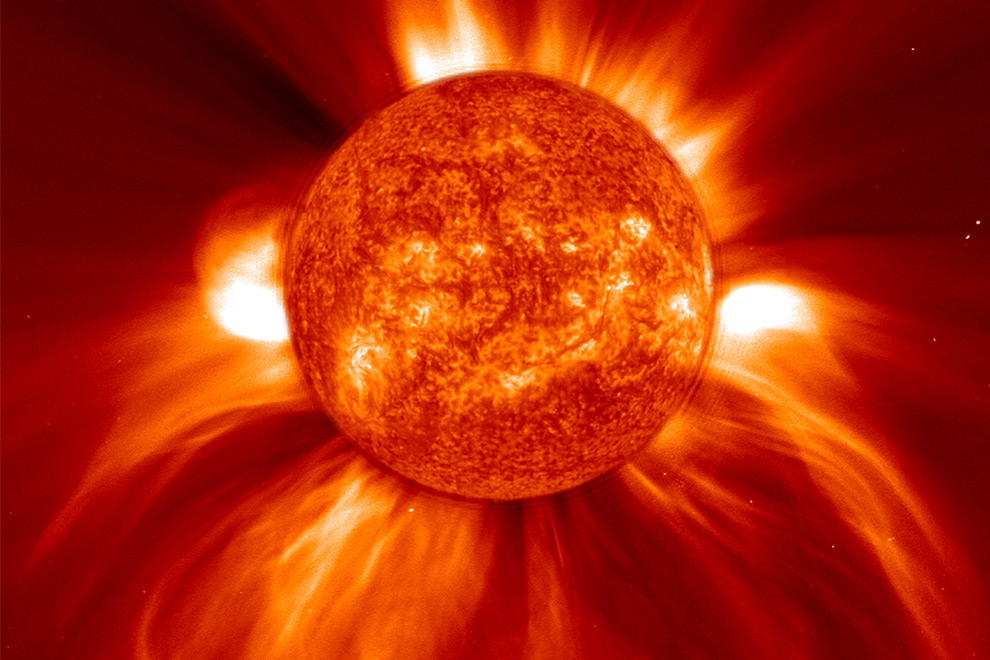Sun Data
Mass: 1.99 X 1030 kg
or 332 946 times Earth’s
Diameter: 1 392 000 km or 109.1
times Earth’s
Surface gravity: 27.9 gees
Surface temperature: 5700 Celsius
Core temperature: 15 000 000
Celsius
Mean rotation period: 25.4 days
Spectrum: G2 V
Distance from galactic centre: 25
000 light-years
Orbital speed in galaxy: 220 km/s
Orbital period in galaxy: 225 000
000 years
The Sun is an ordinary yellow dwarf star. It is a gaseous,
radiating globe 1 392 000 kilometres across, easily big enough to contain the
entire orbit of Earth’s Moon. Like all other stars, the Sun stays balanced
against gravity, in a state called hydrostatic equilibrium, because it has a
nuclear reactor in its heart. There, hydrogen nuclei are smashed together to
make helium, and radiation is released, at a high enough pressure to hold the
star up against gravity. This stage of the Sun’s existence is known as the main
sequence. In the 4600 million years since it was formed, the Sun has changed
very little in terms of general structure. But there are some subtle
differences in rotation rate, luminosity and diameter that are a consequence of its solar
wind, and the way in which it produces energy.
Anatomy of the Sun
Because the Sun is composed entirely of ionised gas – in which
intense radiation has stripped the atoms of their electrons – its mean density
is very low. On average our star is only 1.4 times denser than water. Most of
this material, more properly known as a plasma, is hydrogen, 71 per cent by
mass. Helium accounts for 26 per cent, and the rest is chiefly oxygen, carbon,
nitrogen, neon and iron, also in gaseous form. Despite the low average density,
though, the Sun’s local density varies enormously. Not surprisingly, the
densest part is the centre, crushed under the weight of all the layers on top.
Here, the density is more than 13 times that of solid lead, and the temperature
is 15 million Celsius. This is the Sun’s engine, where hydrogen is processed
into helium. It is known as the core. It accounts for about the innermost 20
per cent of the Sun but contains well over half the star’s entire mass because
the material is so highly compressed. And yet despite this density the core is
still gaseous. Ions roam as freely there as atoms do in a gas.
Just outside the core is the radiative zone. This extends out to
70 per cent of the Sun’s radius. As the name suggests, the radiative zone is
the region where energy is transported away from the core in the form of
radiation. But it takes a very long time. Even here the Sun is so dense that
the little packets of radiation, called photons, travel only a few millimetres
before they hit an ion and bounce off in another, totally random direction.
Because of this it can take individual photons 170 000 years to travel the
length of the radiative zone.
Eventually, though, the photons do reach the edge of the
radiative zone – only to encounter another barrier. This far out in the Sun,
the temperature is only around 2 million Celsius, and the gas is quite opaque.
Thus, as the radiation streams out of the top of the radiative zone, it grinds
to a halt, absorbed by the ions in the cooler gas there. The energy must find
another way to escape to the surface, and it does this with the aid of
convection. As more and more photons arrive at the outer edge of the radiative
zone, the gas there becomes slightly hotter than the material immediately
above. Warm gas is lighter than cold gas. And so the heated gas gets buoyed up
just like a layer of warm water lying on top of colder water in a bath.
Suddenly the heated plasma is displaced upwards in huge units, hundreds of
thousands of kilometres across. These packets of gas rise steadily until, after
about a week, they near the outermost edge of the Sun. Because of the way in
which the Sun’s energy is transported to the surface in this its outermost
third, this region is known as the convective zone.
The rising cells of gas, pushed up through the convective layer,
produce the eventual image of the Sun that we see. As the cells arrive, they
spread out with the pressure of more gas coming up underneath them, and their
cargoes of gas cool down and sink, later to be reheated. The result is the
‘pebble-dash’ appearance that the Sun has in high-resolution photographs – the
so-called solar granulation. This, the visible surface of the Sun, is only
about 500 kilometres thick – thinner than tissue wrapped around a bowling ball.
It is called the photosphere, a name that means ‘sphere of light’. For it is
here that the Sun’s material becomes transparent to optical radiation for the
first time. At last, the photons emitted here can travel unimpeded. They stream
out into space where, 8.3 minutes later, we detect them on Earth as sunlight.
But it is wrong to think of the Sun as having a
solid surface. The
gases in the photosphere have only 10 per cent of the density of the air we
breathe. They merely seem solid because we cannot see beneath them – the gases
there are too absorptive.
The Violent Sun
Aside from granulation, the Sun’s surface has other features.
Most notable are its spots. Sunspots are a result of the Sun’s magnetism. This,
in turn, is a result of rotation and convection. Because the Sun is not a solid
body it rotates differentially: once in 26 days at the equator and once in 30
days at the poles. As a consequence, the Sun’s magnetic field lines, somewhat
like those of a bar magnet, get distorted and stretched as the star spins.
Where the distortion is greatest, the magnetic field becomes amplified and this
inhibits the flow of local gases. This makes these local regions on the Sun
cooler than the rest, and we see them as relatively dark sunspots. On average,
sunspots – which can last just hours or months – have temperatures of around
4200 Celsius, which is about 1500 Celsius cooler than the average surface
temperature of 5700 Celsius. The largest can be bigger than the Earth.
Other aspects of the Sun’s magnetism include solar flares and
prominences. Prominences are great, arch-shaped clouds of gas that hang in the
Sun’s atmosphere – its ‘chromosphere’ – tens or hundreds of thousands of miles
above the photosphere. They are bunches of gas, denser than the gas around
them, entrained in magnetic loops, and have lifetimes of several hours. Flares
are sudden explosions that originate near active regions, heating up the gas in
the chromosphere and corona – the outermost atmosphere – to temperatures of
hundreds of millions of degrees. A typical flare will blast a cloud of charged
particles – electrons, protons and other atomic nuclei – away from the Sun at
speeds of up to 70 per cent that of light. Also related to the corona are the
so-called coronal mass ejections. Nobody understands exactly what drives them,
but coronal mass ejections involve the sudden expulsion of up to 10 trillion
kilograms of hot plasma at speeds of up to 1000 kilometres per second. They
create shockwaves in the Sun’s solar wind – its steady stream of mainly
electrons and protons – that can seriously disrupt communications on Earth.
The Changing Sun
So the Sun is a violent place. But it is not as active as it
used to be. During the millions of years it took to form, the Sun got spun up
by the gases that fell onto it from the Solar Nebula. Since the nebula
dispersed, however, the rotation has slowed down considerably. This is because
of the interplay between the solar wind and the Sun’s magnetic field. As the
wind blusters into space, some of it gets channelled along magnetic field
lines. This redistribution of some of the Sun’s mass radially away from it acts
to slow it down, just as a ballet dancer slows down when he extends his arms
away from his body after a spin. Both the dancer and the Sun are said to be
conserving angular momentum – and, in the Sun, the process is known as magnetic
braking. The Sun now spins once in 26 days at the equator, compared with once
in 8 days or fewer when it was a T-Tauri star. This produces a weaker magnetic
field, and is why the Sun is now a lot less magnetically active than it used to
be, fortunately for us.
There is another way in which the Sun has altered. Because the
core has been converting hydrogen into helium for so long, its composition has
changed somewhat since the star started to shine. Now, 37 per cent of the core
hydrogen has been consumed, replaced with helium, and this has had consequences
for the outward appearance of the Sun. Four hydrogen nuclei go into the making
of every single helium nucleus. Each helium nucleus exerts the same pressure as
a hydrogen nucleus. But because the total number of nuclei in the core becomes
fewer and fewer as more hydrogen nuclei are consumed, the pressure there drops
steadily all the while the Sun is on the main sequence. As a result, its core
is always contracting, growing a bit hotter. This produces more energy that in
turn puffs the Sun up a little and makes it more luminous. Over time, the
change in luminosity can become quite significant. Already the Sun is about 10
per cent larger than it was when it emerged from its birth cloud, 4600 million
years ago. It is also slightly warmer, and about 30–40 per cent more luminous.
This trend will stay with the Sun until the end of the main sequence, more than
6 billion years from now.
Source :
Mark A. Garlick. The
Story Of The Solar System. University Press: Cambridge.
2002.












0 comments:
Post a Comment